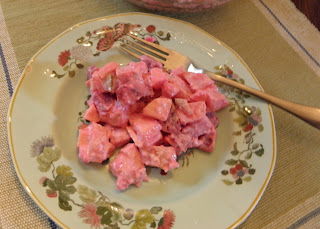We have so many ethnic food choices in the USA. At any given meal, we can eat cuisine with influence from almost anywhere in the world at a local restaurant. We can eat take-out of almost any kind and most of us know at least a recipe or two to cook up in our own kitchen that isn't originally from our own ethnic background.
My husband, Avo, is Estonian. Both of his parents immigrated to the USA following World War II. His first language was Estonian, his early years were spent in a thriving and tight knit Estonian community in Chicago. As in most ethnic communities, opportunities to get together included traditional food.
 |
| Estonian Flag |
One Estonian side dish that I delight in is Rosolje [
row-
sohl-
yeh]. My appetite for Rosolje may be one of the little things that contributed to my change of status from out-law to in-law in my husband's family. I love this salad. I consider it a complete meal in itself. It contains all kinds of wonderful and nutritious goodies; pickled beets, apples, dill pickles, and sour cream, meat and eggs for protein.
When I've questioned my mother-in-law about the origins of Rosolje, she shrugs with the common response of someone being questioned about their own cultural traditions "It's just always been there. My mom made it, then I made it." Too familiar to question, we had to do a bit of research to learn the history.
Traditionally served in the fall, you may also find this amazing salad at any gathering, including the summer solstice, Jaanipaev celebration. Rosolje became popular in the 1920's, originally made with herring (common Estonian fare), it has evolved and each cook adds the meat of her choice. The measurements of each ingredient were hard to pin down, even the published recipes vary in individual amounts per ingredient. When I make it, I have done the same and fortunately, my results have been given the nod of approval from both my kids and mother-in-law, from where I was gifted the recipe.
Thanks, Tiina.
Here's the recipe.
 |
| Rosolje - Serve cold. |
Cube the following ingredients:
2 cans of pickled beets (Aunt Nellie's) Save the juice.
5-6 dill pickles
4 apples (Granny Smith or Golden Delicious)
6 big potatoes - boiled and peeled
3 hard boiled eggs
Cooked cold meat - cooked cold pork roast, smoked turkey or smoked ham are a few of the possibilities. I use ham and have never tried it with the traditional herring. Cube about 1 - 2 cups.
Get some help for cubing (it takes awhile). The expert Estonian cooks say, whatever size you cube the ingredients into, to try to get all of the cubes the same size.
For the dressing:
1 1/2 cups sour cream
1 1/2 teaspoon dry mustard (Colman's)
Add beet juice until you have the desired pink.
Mix it all together. Refrigerate for several hours.
Serve cold.
 |
| Mix dressing to desired pink. |
 |
Handing down a traditional recipe.
Adah and Grama Tiina. |
This recipe shared on Creative Muster.




